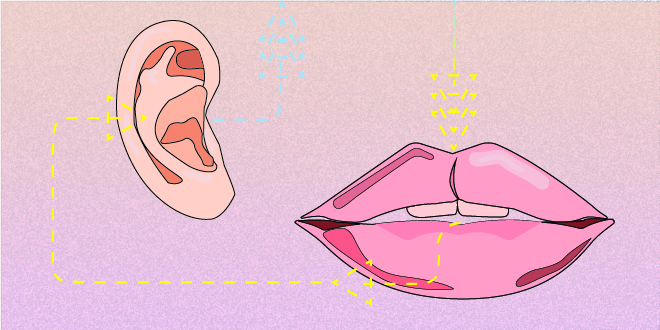How to Speak to Be Heard

Illustration by Lisa Chan.
When I first started writing this article, I envisioned it being a word-to-word combat manual— “How to Win a Fight Without Lifting a Finger.” In what ways could I help arm you, the reader, when you are dropped into the battleground of obnoxiously loud opinions? However, upon reflection, I feel like that would go against the way communication can best be utilized.
I’ve always had a problem with praising debate while overlooking other forms of communication. As an audience, we like to see a good fight in which words are used to rip wounds open, rather than to heal the damage that has already been done. Entertaining? Yes. Meaningful? Not quite.
When I think of communication, I envision an attempt to understand one another. We are too often preoccupied with planning what we want to say next, so much so that we forget to listen to the person we’re supposed to be conversing with. In an attempt to work against this way of thinking, I’ve developed a guide that explains how to communicate with a possible future ally.
- Decide what type of conversation you wish to have.
If your goal is to be heard, do not reduce the conversation to a debate. The purpose of debate is for each side to prove the other wrong, as opposed to dialogue, where the goal is to find the commonalities they may share. If you engage in the conversation with the understanding that each of you are attempting to find the truth through the commonalities and differences in your experiences, you are much more likely to come to an understanding.
- Put out what you’re expecting others to bring in.
By this, I mean that as a participant within the conversation, you have the power to shape its overall influence. If you want to feel the freedom of expressing yourself, and having your thoughts be heard, you have to be willing to give that same respect to the person whom you are talking to. If you want the conversation to go past the surface level, you have to be willing to create the space for others that you wish to have yourself. Conversations that focus on the “give” rather than the “take” have a much more positive impact.
- Don’t believe everything you think.
We are all influenced by the circumstances, experiences and institutions that make up the life and world we know. Our position in the world is important, and in sharing our experiences with others who may see the world differently, we have the ability to expand their knowledge of interactions they themselves have never taken part in. However, this goes both ways. Going into these conversations, we must be able to maintain an open mind and an open heart.
The power of this method of communication has great potential. Hearing facts on their own has a much lower impact than hearing them in a context that confronts one’s personal prejudices. The article “How Do You Change Voters’ Minds? Have a Conversation“ explains how by going door to door and talking to voters about their personal experiences with the LGBTQ community, they are more likely to relate their own experiences to LGBTQ issues and vote in favor of LGBTQ rights. This strategy has been used in getting same-sex marriage legislation passed and is currently being used to encourage support for transgender restroom access.
Utilizing dialogue has also proven to be valuable in abortion storytelling. Rep. Tim Ryan has gone on the record saying that his decision to support abortion rights is directly correlated to the women who have shared the factors that went behind their choice. In addition to personal one-on-one interactions, abortion storytelling has also spread to prominent internet forums, with hashtags such as #ShoutYourAbortion trending on Twitter.
Our patriarchal society has taught us to use our words as weapons, but imagine the world of difference that could be made if our words were used as an apparatus for understanding. The answer of how to speak to be heard isn’t necessarily in the act of speech itself– it’s in the listening.




